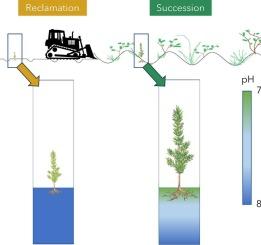挪威云杉在先锋树下的自然再生优于传统的采矿后复垦
IF 4.1
2区 环境科学与生态学
Q1 ECOLOGY
引用次数: 0
摘要
植树造林是恢复矿区后土地的可行途径之一。以前的研究表明,在有利的条件下,森林可以通过自然更新在自发演替发展的采矿后地点自发建立,通常是先锋树种的殖民地。而晚演替树种的建立是森林发展的重要步骤。在这里,我们评估了挪威云杉(Picea abies)在通过自然演替发展的演替地点的先锋树林下的生长情况,并与在常规开垦地点种植的云杉幼苗进行了比较。对14岁云杉的比较表明,生长在先锋种林下的云杉明显更高,针叶中叶绿素和磷含量更高,根尖菌根比例更高,土壤中麦角甾醇含量更高。然而,演替地志愿云杉的密度明显低于复垦地的种苗密度。复垦地的表层土壤呈碱性(pH ~ 8),而演替地的表层土壤pH值明显较低(<7.5),这可能是由于土壤表面有机质积累较多。土壤pH值与树高、针叶磷和土壤麦角甾醇含量呈负相关。我们认为,演替地pH值的降低是提高其适树性的主要因素。常规填海方法中常见的地面平整和随后的植树,可能会导致比自然演替和现场种子自然发芽所产生的更不利的场地条件。本文章由计算机程序翻译,如有差异,请以英文原文为准。

Natural regeneration of Norway spruce under pioneer trees outperforms conventional reclamation on post-mining sites
Afforestation is one of the feasible ways to restore post-mining land. Previous studies have shown that, under favorable conditions, forests can spontaneously establish through natural regeneration on post-mining sites developing by spontaneous succession, often colonized by pioneer tree species. However, the establishment of late-successional tree species is an important step in forest development. Here, we evaluate the growth of Norway spruce (Picea abies) in the understory of pioneer trees in successional sites developed through spontaneous succession, in comparison with spruce seedlings planted on conventionally reclaimed sites. The comparison of 14-year-old spruce trees shows that those growing in the understory of pioneer species are significantly taller, have higher chlorophyll and phosphorus content in their needles, a greater proportion of mycorrhizal root tips, and a higher content of ergosterol in the soil beneath them. However, the density of volunteer spruce trees on successional sites is significantly lower than the density of planted seedlings on reclaimed sites. Topsoil in reclaimed sites is alkaline (pH ∼8), whereas in successional sites, the pH is significantly lower (<7.5)—likely due to the greater accumulation of organic matter on the soil surface. Soil pH is negatively correlated with tree height, as well as needle phosphorus and soil ergosterol contents. We propose that the decrease in pH on successional sites is a major factor increasing their suitability for tree establishment. Surface leveling and subsequent tree planting, common in conventional reclamation practice, may result in less favorable site conditions than those arising from spontaneous succession and on-site natural seed germination.
求助全文
通过发布文献求助,成功后即可免费获取论文全文。
去求助
来源期刊

Ecological Engineering
环境科学-工程:环境
CiteScore
8.00
自引率
5.30%
发文量
293
审稿时长
57 days
期刊介绍:
Ecological engineering has been defined as the design of ecosystems for the mutual benefit of humans and nature. The journal is meant for ecologists who, because of their research interests or occupation, are involved in designing, monitoring, or restoring ecosystems, and can serve as a bridge between ecologists and engineers.
Specific topics covered in the journal include: habitat reconstruction; ecotechnology; synthetic ecology; bioengineering; restoration ecology; ecology conservation; ecosystem rehabilitation; stream and river restoration; reclamation ecology; non-renewable resource conservation. Descriptions of specific applications of ecological engineering are acceptable only when situated within context of adding novelty to current research and emphasizing ecosystem restoration. We do not accept purely descriptive reports on ecosystem structures (such as vegetation surveys), purely physical assessment of materials that can be used for ecological restoration, small-model studies carried out in the laboratory or greenhouse with artificial (waste)water or crop studies, or case studies on conventional wastewater treatment and eutrophication that do not offer an ecosystem restoration approach within the paper.
 求助内容:
求助内容: 应助结果提醒方式:
应助结果提醒方式:


